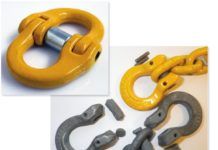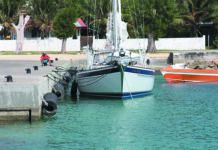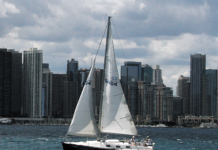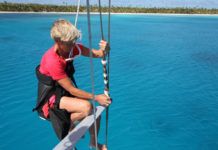It is not enough for the boat to be able to handle the conditions, she also has to carry a crew and everything they need, and give them a safe and relatively comfortable space to live in on passage. When you’re crossing an ocean there is nowhere to stop and re-supply or get spares. I know this sounds obvious, but it has major implications.
To cross oceans, a boat must be able to carry enough fuel, water and supplies for the crew for the duration of the trip and passages may be measured in months not weeks. She also has to carry spares and tools to deal with anything that goes wrong on passage. All this stuff weighs a significant amount and has to be stowed somewhere. I have seen estimates that a long-distance ocean passage boat will typically add about 2 1/2 tons to her light ship displacement and this agrees pretty closely with my own experience.
If a boat has been approved for sale in Europe, it is required to display a plate showing its carrying capacity. For boats from other countries the information should be available somewhere in the documentation or on a plate attached to the boat. It is vital to know these numbers. A boat may be classified as suitable for ocean sailing but only if you stay within this load limit. If you exceed it, then its rating goes down. So an overloaded category A ocean boat may now only be classified at category C for coastal sailing. You may need to hunt for this information as most manufacturers don’t list it in the boat’s basic information.

The example in the image above is the plate for a Beneteau Oceanus 46.1. The letters refer to her rating, A is ocean, D is inshore. The second row refers to the maximum load she can carry in kg and includes both people and stores.
Let’s assume you want to carry a crew of three. For CE marks, a person is assumed to weigh 175 lb. or 80 kg so that means about 240 kg (529.1 lb.). You are now left with a little over 1,200 kg (2,645.5 lb.) for everything else. Although this does not include the weight of the tanks fitted by the manufacturer when full, it does have to cover the weight of everything else you bring on board. So let’s think about what that means.
- Ground tackle: 2 anchors, one with chain and one with mixed chain and rope rode = 375 kg (826.7 lb.)
- 10-ft. RIB plus 15 hp engine = 175kg (385.8 lb.)
- Personal baggage (based on what you can take on a plane) 30 kg per person = 90 kg (198.4 lb.)
- Food for 8 weeks @ 1.5 kg per person per day = 252 kg (555.6 lb.)
- Crockery, cutlery and cooking and other galley equipment = 100kg (220.5 lb.)
- Toolbox = 25 kg (55.1 lb.)
- Essential spares (alternator, starter motor, oil etc.) = 100 kg (220.5 lb.)
- Safety equipment (first aid kit, MOB, Life-raft etc.) = 75 kg (165.3 lb.)
Oops, we just hit the load limit, so you have no bedding, sail repair stuff, navigation and radios, radar, watermakers or toys like snorkeling gear etc. And this is a 46-ft. boat! So is she a “bluewater boat”?
Compare these numbers with the Beneteau Oceanis Clipper 393, which is a more traditional design by the same builder. Although 7 ft. shorter, she has a full 1000 kg (2,204.6 lb.) greater load capacity!
Overweight Boats
I suggest this is the most frequently overlooked aspect of assessing a boat for ocean sailing. How many times have you seen boats in the yard that have had the waterline raised? I have seen lots. It is primarily a problem with production boats aimed at charter or Caribbean/Mediterranean cruising and “fast” cruisers, which are based on race designs. Yes, they may be able to justify an ocean rating if you equip them like a race boat and are prepared to live on dehydrated food but with a “normal” amount of stuff most people would want to carry for an ocean passage they are going to be way over their weight limit. For a true bluewater boat, I would ideally want to see a load carrying capacity of 2,500 kg 5,511.6 lb.). For a boat in the 35 to 40 ft. range.

Storage Space
In addition to the boat’s ability to carry what is needed is the ability to store it. A significant difference between a bluewater boat and one for coastal passages is that it should have larger lockers—probably amounting to two or three times the stowage space you would find on an average coastal cruising boat. Lack of stowage space is a frequent issue with people cruising long term on production boats. Typically most production boats and ones aimed at coastal cruising are designed around week-long voyages and have stowage for the sort of stuff you would carry for that duration.
When you start looking at storing a spare alternator, emergency stays, gallon cans of engine oil, hydraulic fluid for the gearbox and steering, spare blocks etc. let alone extra clothes and a couple months’ worth of food, you rapidly run out of space. This is not just inconvenient. More importantly, it makes it hard to stow stuff in a way that makes it accessible and safe. If a shroud lets go you need the spare ASAP. If it is buried underneath a spare bunk with a pile of other boxes stowed on top of it that could be an issue.
Rig Stress
The next big difference is the stress the boat and rig have to take. Even on the trade wind routes the seas will be bigger than what you usually encounter in coastal waters. Ten-foot seas are not considered heavy weather offshore, they are quite normal. Sailing downwind in this sort of sea the boat will probably be rolling 20 degrees each way for weeks on end. Rigging will get stressed and a line rubbing even slightly on something will chafe through.
This is a major difference between a coastal boat and one for ocean crossing. All her equipment needs to about one step up. That includes the wire size on the rigging, all the chainplates, the tangs on the mast, the size and quality of the blocks and running rigging. It is also normal for sails to have triple stitching with heavier grommets and more reinforcement.
Stability
The last factor we need to look at to consider a boat to be seaworthy is stability. If the boat is classed as category A she is supposed to be sufficiently stable for ocean a sailing. If you are happy to take the marketing on trust alone, you can skip the next section. Understanding sailboat stability gets quite complex but I want to explain the basics. As a skipper you are ultimately responsible for knowing your boat is safe and I am not sure if just checking that it has a cat A rating is enough.
Stability is simply the term for what is keeping the boat upright. To talk about what keeps your boat upright, I need to explain a few terms.
Moments
This has nothing to do with time but instead measures the effect things like the keel have. It is quite simple. Take a stick and hang a weight on it, now hold it out straight and see how hard it is to hold. Next move the weight along the stick so that it is twice as far away from your hand. It will now be twice as hard to hold it up! The force the keel exerts to bring your boat upright is the same, its weight times the distance from the center of buoyancy is called the keel’s righting moment. So if you double the keel weight it has the same effect as doubling the draft. That’s why race boats have very deep keels.
Center of Effort or Buoyancy
When we look at sailboat design, we generally calculate things like buoyancy or the force on sails as if they act in one place. Obviously, the pressure on a sail or the buoyancy in a hull is spread across the whole area but we can do calculations as if it was concentrated in one spot. This is called its center, so the force on a sails acts through the center of effort of all the sails added together. The resistance a boat has to moving sideways acts through its center of lateral (i.e. sideways) resistance. The weight of the keel acts through the keel’s center of mass and the buoyancy acts through the hull’s center of buoyancy.
Forces on a sailboats simplified:

arm (GZ). The righting moment (RM) is the torque developed at specific angles of heel (the hull resists the heeling moment: RM = GZ x displacement. (Illustration by Regina Gallant)
Inertia
This is slightly trickier. Inertia is a measure of how hard it is to make something change what it is doing. Imagine taking a bowling ball and a balloon. If you want to throw the bowling ball, it takes a lot of effort to get it moving but once it is going it will roll all the way down the lane. It has a lot of inertia. If you try to do the same thing with the balloon it is very easy to get it moving but then it stops really quickly. It has very little inertia. The inertia of a boat has a lot of impact on its performance.
If we start with the boat perfectly upright in still water, then the weight of the boat and keel are acting straight down and the buoyancy is acting straight up. These two forces exactly match each other and the boat does not move.
If we now tip the boat over to 90 degrees, the buoyancy is still acting straight up but now only the weight of the hull is acting straight down, the keel is now sticking out sideways and trying to force the boat back upright. The force it is generating acts through the center of mass of the keel, and is the weight of the keel times the distance to its center of mass. At 90 degrees that is simple but what if we only tip the boat to 45 degrees. In this case the righting moment is the keel weight times the horizontal distance, not the draft, and will be about half as much.
So the further the boat heels, the more force the keel exerts to bring her back upright. What happens if we go past 90 degrees? The righting moment now decreases until the boat is perfectly upside down and in theory could balance on the mast.
Hull Width
This would describe how the boat behaved if the hull was perfectly circular but of course boats are not. In a real boat, as she heels one side is pressed down into the water while the other side is lifted up. This means the center of buoyancy moves and helps to keep the boat upright. The wider the hull is the more effect this has. So a boat with a broad beam takes more force to make it heel. Again, that’s why race boats are so wide.
Angle of Vanishing Stability. But what happens to a very wide boat if you heel past 90 degrees? At some point the weight of the weight of the keel will be closer to the center of the boat than the center of buoyancy. This point is called the angle of vanishing stability. Once you pass this point, she will keep going to fully inverted. Now how does she now get back upright? She needs a push, if you inverted the boat on a flat calm day she could actually stay that way until she sank. Fortunately, in the real world boats don’t capsize in a flat calm so what actually happens is that the next wave tips her over enough for the keel’s righting moment to take over again and she will come back up.
When a boat has moderate beam, she will tend to initially heel and roll more readily. On the plus side she will have a high angle of vanishing stability so is readily self-righting. A wider boat is the reverse, she has higher initial stability but a lower angle of vanishing stability. The traditional ratio that was always considered appropriate for a blue water boat was a length to beam ratio of about 3:1, so a 30-ft. boat would have a beam of 10 ft. While the actual numbers have changed over time for various reasons, staying near that number is still considered the “safe” option.
Wider Beams. There are currently any number of boats being made that carry the A rating, suitable for oceans, which have a much wider beam than was traditionally considered appropriate for blue water. Many current offshore race boats will have ratios of between 1:4 and 1:6 in order to get super high initial stability and carry huge amounts of sail but they also have a canting keel so if you do capsize the chances are the keel will not be straight up but out to one side. Just because a professional sailor can take a boat solo in a round-the-world race does not mean I would want to pick one for short-handed long distance cruising with a family onboard.
This is what stability curves typically look like for a modern wide and shallow hull compared to a traditional narrow heavy boat:

Now let’s look at how sailboats capsize in the real world. First, it is not wind because the stability graph only tell half the story. The wind can heel a boat but before it even gets to 90 degrees the wind will just slide of the top of the sails and cannot push the boat any further. It is always waves that capsize a boat. When a steep wave crashes against the side of a boat it gets hold of all the topside area and pushes against it. The boat will try to resist this in exactly the same way that it resists heeling but there is another factor that comes into play. When the wind heels the boat, it is generally a steady pressure but a wave is a sudden hit and this makes a lot of difference. What we are talking about here is dynamic stability.
Dynamic Stability
This is crucial to understanding how a boat will perform in real sea conditions and it is not something you will see when you look at the boat’s statistics. In fact, it is very difficult to measure in a meaningful way. Once you understand what dynamic stability is, however, it is not that difficult to make a subjective assessment. I can illustrate it quite easily. If you jump into the dinghy from the dock it will rock quite a lot. This is because your moving weight carries a lot of energy and the dinghy is light and has low dynamic stability. If you step carefully into the dinghy it won’t rock much. You just transferred the same load into it, you just did it slowly. Now imagine the same jump from the dock to your cruising boat. She probably will barely move at all. The force your jump imparted to her was not enough to get her moving.
A wave crashing into the side of a boat is the same as you jumping into the dinghy only the wave weighs several tons not a hundred pounds or so! If a wave hits the boat hard enough it can capsize her and in the real world this is what make boats capsize. The static stability curve tells you a lot about how far a boat will heel from the wind and how well she will self-right but it is her dynamic stability that governs if she will get knocked down or capsized by a wave.
What Makes a Boat Dynamically Stable?
Inertia, and more particularly moments of inertia, makes a boat dynamically stable. Let’s do a thought experiment. Take your boat hook, hold it in the middle and try to spin it like a drum major’s baton. It would be quite easy to do. Now put a heavy weight in the middle and spin it again. It may be harder to lift but it won’t be much harder to spin. If you could now split that weight in half and move each half to the ends of the boat hook and try spinning it, it would become very difficult to get it moving. What’s going on?
Inertia is how much energy you need to apply to something to get it moving and it depends on how much it weighs. Moment of inertia depends on not just the weight but how far away from the axis of rotation it is. This is similar to what we had with the keel, the righting moment was the keel’s weight times draft, that told us the static force the keel exerted to right the boat. The difference with moments of inertia is that they tell us how hard it is to accelerate something.
Why Does Acceleration Matter?

Unlike the wind, which blows fairly steadily, a wave hits the boat but then passes by. When the wave hits the boat is not rolling. In order to capsize the boat the wave has to accelerate the boat from not turning to turning fast enough to get to its angle of vanishing stability before it passes. Breaking crests pass in seconds not minutes, so the boat needs a high enough dynamic stability to resist that acceleration for a short time only.
What Affects Dynamic Stability?
Think back to the experiment with the boat hook. When the weight was in the middle it did not make it much harder to turn so the weight of the hull does not have much effect. When we moved the weights out to the ends it became hard to turn. The boat’s keel is a big weight on the end of the stick underwater but the weight of the rig is another weight on a much longer stick. A boat with a big heavy keel resists being heeled by waves but the weight of the rig also has a surprisingly large effect.
Dynamic Stability in Normal Conditions
We have been talking about dynamic stability in terms of resisting capsizing but it is also important in normal conditions. The greater the boat’s dynamic stability is, the slower and steadier her motion will be in any conditions. This makes a great deal of difference. If a boat dances around and has a rapid, jerky movement in a moderate sea state, we could not only conclude that she may have a low resistance to capsize but also that she is going to be exhausting to move around on in a normal sea state as well.
It is often not how far a boat rolls that makes her uncomfortable but how fast she does it. This is why a lot of experienced ocean sailors stick with traditional, moderate to heavy displacement boats. They may be reassured by their ultimate seaworthiness, but more importantly they are just way more comfortable the rest of the time!
Conclusion
In conclusion, your choice of a suitable boat for offshore sailing should be as much about evaluating the crew as it is about evaluating the boat. Do you have a crew that is fit, strong and experienced and will enjoy the challenge of controlling a fast powerful boat? Are you a couple in your senior years not sailing to a time schedule but wanting a boat that will look after you and be easy to handle? Or are you sailing with a young family and want the safest possible boat with a very easy motion?







































Where in BC do you live ? Have you any thoughts on the suitability for off shore , and how about the stability of a Passport 42 ? We have a 1980 Fraser 36 and one of my brothers is looking at a 1982 Passport 42 .
Great article, thank you. I’m rebuilding a Frances 26 in preparation for an Atlantic crossing. Yes, she is small but I’m doing this solo so the weight I carry is somewhat less. The length to beam ratio is 3.1, displacement is 6,800 lbs., more specs are online plus some of the more recent keel and rudder changes from the original designer Chuck Paine at his website. I’d appreciate it if you could provide a little guidance (or point me in the right direction) regarding a safe loading capacity. Understanding of course that safe is a relative term. I’m still building out the deck, selecting an engine, and need to spec the mast and sail plan so there is some flexibility in the overall displacement and where I can put some of the weight.